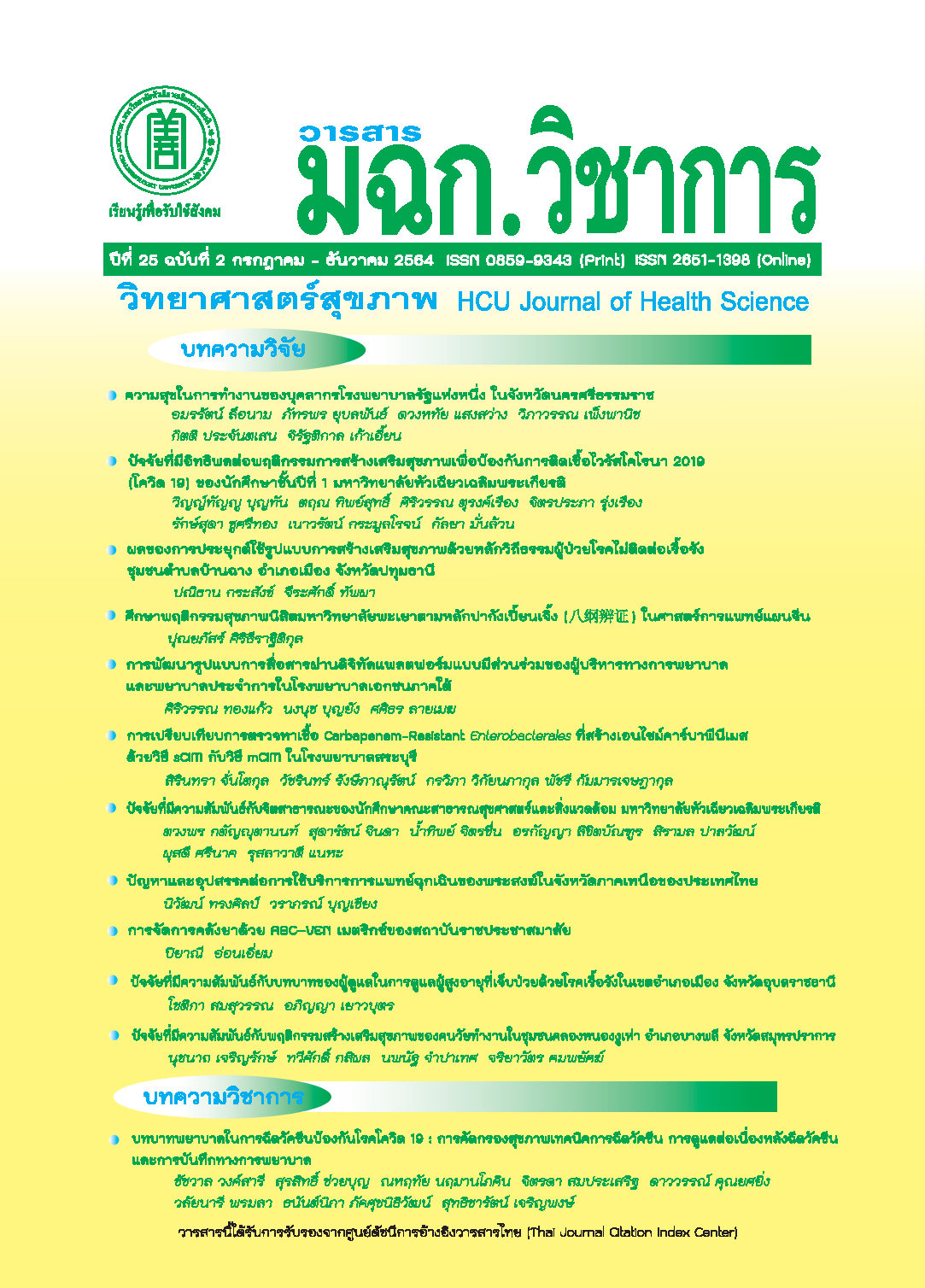The Outcomes of Applying Way of Dhamma of Life Principles for the Health Promotion Model for Chronic Non-Communicable Disease Patients, Ban Chang Sub-district, Muang District, Pathum Thani Province
Keywords:
the way of Dhamma of life, non-communicable disease, Health Promotion ModelAbstract
The objectives of the study were to 1) compare blood glucose levels and blood pressure levels of the experimental group before and after applying the health promotion model based on the principles of Dhamma’s way in Ban Chang subdistrict, Muang district, Pathum Thani province, 2) compare blood glucose levels and blood pressure levels between the experimental group and the control group after applying the health promotion model based on the principles of Dhamma’s way, and 3) compare the behaviors in practice in the health promotion between the experimental group and the control group after applying the health promotion model based on the principles of Dhamma’s way. The samples were divided into 2 groups, which were the experimental group and the control group. The experimental group consisted of 36 diabetes and hypertension patients as a chronic non-communicable disease, and the control group was 36 non-disease persons which were selected by purposive sampling. The tool for the experiment was the health promotion model based on the principles of Dhamma’s way comprising 3 ส. practices ( praying practice, meditation practice, and Dhamma dialogue practice), 3 อ. Practice (physical exercises, foods, and emotions), 1 น. Practice ( implementation of 3 ส., 3 อ. for the way of life. In each activity of practice consumed 1 hour which was intermittent time 1 week. The tool for collecting data was a questionnaire on the health promotion model based on the principles of Dhamma’s way and checked the content validity by 5 experts. The index of Item-Objective Congruence (IOC) of a questionnaire was 0.71 with a reliability level of 0.70. The data were analyzed by the statistics of percentage, mean and standard deviation. The comparisons of blood glucose levels and blood pressure levels of the experimental group before and after applying the health promotion model are based on the principles of Dhamma’s way using pair sample t-test. While the comparisons of blood glucose levels and blood pressure levels between experimental group and control group as well as behaviors in practice after applying using independent sample t-test.
The results of this study showed that blood glucose levels and systolic blood pressure levels of the experimental group after applying the health promotion model based on the principles of Dhamma’s way had lower than before applying, at a statistical significance level of .01. The blood glucose levels and systolic blood pressure levels of the experimental group revealed that reduce more than the control group at a statistical significance level of .01. While the mean of the experimental group after the health promotion model based on the principles of Dhamma’s way had higher than the control group at a statistical significance level of .01.
Downloads
References
สำนักโรคไม่ติดต่อ กรมควบคุมโรค กระทรวงสาธารณสุข. รายงานเฝ้าระวังโรคทางระบาดวิทยา. กรุงเทพฯ: โรงพิมพ์ชุมนุมสหกรณ์การเกษตรแห่งประเทศไทย; 2553.
กองระบาดวิทยา กรมควบคุมโรค กระทรวงสาธารณสุข.รายงานสถานการณ์โรค NCDs. นนทบุรี: สำนักพิมพ์อักษรกราฟิคแอนด์ดีไซด์; 2563.
สำนักระบาดวิทยา. สรุปรายงานการเฝ้าระวังโรค ปี 2561 [อินเทอร์เน็ต]. [เข้าถึงเมื่อ 21 เมษายน 2561]. เข้าถึงได้จาก: http//203.157.15.4/Annual/ANNUAL2550Part1AnnualMennuPart1.html
สำนักโรคไม่ติดต่อ กรมควบคุมโรค กระทรวงสาธารณสุข. แผนยุทธศาสตร์การป้องกันและควบคุมโรคไม่ติดต่อระดับชาติ 5 ปี (พ.ศ. 2560 - 2564). กรุงเทพฯ: บริษัท อิโมชั่น อาร์ต จำกัด; 2560.
กลุ่มพัฒนาระบบสาธารณสุขสำนักโรคไม่ติดต่อ กรมควบคุมโรค. ประเด็นสารรณรงค์วันความดันโลหิตสูงโลก ปี 2561 [อินเทอร์เน็ต]. [เข้าถึงเมื่อ 10 ธันวาคม 2561]. เข้าถึงได้จาก: http://www.thaincd.com/document/file/info/non-communicable-disease
ข้อมูลบันทึกทะเบียนประวัติรายงานสุขภาพประจำปี ฝ่ายทะเบียน เขตบริการสุขภาพที่ 4 จังหวัดปทุมธานี. 2562.
ข้อมูลทะเบียนประวัติรายงานสถิติประชากรประจำปี สำนักทะเบียนองค์การบริหารส่วนตำบลบ้านฉาง อำเภอเมือง จังหวัดปทุมธานี. 2562.
ข้อมูลบันทึกทะเบียนประวัติรายงานประจำปีผู้ป่วยเข้ารับการรักษาต่อเนื่องโรงพยาบาลส่งเสริมสุขภาพตำบลบ้านฉาง อำเภอเมือง จังหวัดปทุมธานี. 2562.
อุทัย สุดสุข. สาธารณสุขในพระไตรปิฎก บูรณาการสู่สุขภาพดี ชีวีมีสุข. พิมพ์ครั้งที่ 2. กรุงเทพฯ: เทพประทานการพิมพ์; 2554.
กองยุทธศาสตร์และแผนงาน สำนักปลัดกระทรวงสาธารณสุข. แผนพัฒนาสุขภาพแห่งชาติฉบับที่ 12 พ.ศ. 2560 – 2564 อินเทอร์เน็ต]. [เข้าถึงเมื่อ 22 ตุลาคม 2563]. เข้าถึงได้จาก: https://bps.moph.go.th/new_bps/
สำนักบริหารการสาธารณสุข สำนักปลัดกระทรวงสาธารณสุข และมูลนิธิอุทัย สุดสุข. รูปแบบโครงการสร้างเสริมสุขภาพ วิถีพุทธ. กรุงเทพฯ: โรงพิมพ์นิวธรรมดา; 2556.
สำนักบริหารการสาธารณสุข สำนักปลัดกระทรวงสาธารณสุข และมูลนิธิอุทัย สุดสุข. สรุปผลการสัมมนาพัฒนารูปแบบสุขภาพที่ดี วิถีพุทธ ด้านการสร้างสุขภาพและรักษาพยาบาล ปี 2557. นนทบุรี: กระทรวงสาธารณสุข; 2557.
Kirk RE. Experimental design: Procedure for the behavioral sciences. 3rd ed. Pacific Groves: Brooks/Cole Publishing Company; 1995.
นงลักษณ์ วิรัชชัย. ชุดวิชา 21701 การวิจัยหลักสูตรและการเรียนการสอน หน่วยที่ 10 สถิติวิเคราะห์ เชิงปริมาณ: สถิติบรรยายและสถิติพาราเมตริก. มหาวิทยาลัยสุโขทัยธรรมาธิราช กรุงเทพฯ: โรงพิมพ์มหาวิทยาลัยสุโขทัยธรรมาธิราช; 2553.
ลัดดา ปิยเศรษฐ์. การศึกษาการพัฒนารูปแบบการสร้างสุขภาพดี วิถีพุทธ ในการป้องกันและแก้ไขปัญหาโรคเรื้อรังในชุมชน: กรณีศึกษาบ้านคุยป่ารัง อำเภอพรานกระต่าย จังหวัดกำแพงเพชร. นนทบุรี: กรมสนับสนุนบริการสุขภาพ กระทรวงสาธารณสุข; 2557.
Cohen J. Statistical power analysis for the behavioral sciences. 2nd ed. Hillsdale, NJ: Erlbaum; 1988.
ข้อมูลบันทึกทะเบียนประวัติรายงานประจำปีผู้ป่วยเข้ารับการรักษาต่อเนื่องโรงพยาบาลส่งเสริมสุขภาพตำบลเชียงรากน้อย อำเภอบางปะอิน จังหวัดพระนครศรีอยุธยา. 2562.
บุญเชิด ภิญโญอนันตพงษ์. สถิติการศึกษาวัดผล. ภาควิชาพื้นฐานการศึกษา. กรุงเทพฯ: มหาวิทยาลัยศรีนครินทรวิโรฒ; 2545.
อุทัย สุดสุข. สาธารณสุขในพระไตรปิฎก บูรณาการสู่สุขภาพดี ชีวีมีสุข. พิมพ์ครั้งที่ 2, กรุงเทพฯ: เทพประทานการพิมพ์; 2554.
พระพรหมคุณาภรณ์ (ป.อ.ปยุตโต). พจนานุกรมพุทธศาสน์ ฉบับประมวลศัพท์. พิมพ์ครั้งที่ 11. กรุงเทพฯ: เอส.อาร์.พริ้นติ้ง แมสโปรดักส์ จำกัด; 2551.
จินดารักษ์ สมใจนึก, จอม สุวรรณโณ. ความสัมพันธ์ระหว่างอายุที่มีความดันโลหิตสูงและความดันโลหิตสูงในวัยเปลี่ยนผ่านของวัยรุ่นตอนปลายถึงวัยผู้ใหญ่ตอนต้น. วารสารการพยาบาลหัวใจและทรวงอก 2563; 31(2): 63-77.
สมพร กันทรดุษฎี. การปฏิบัติการเพื่อการเยียวยาสุขภาพ. พิมพ์ครั้งที่ 9. กรุงเทพฯ: สำนักงานกิจการพิมพ์องค์การทหารผ่านศึก; 2552.
ทรงเดช ยศจำรัส, ปาริชา นิพพานนท์. ผลการพัฒนาความสามารถของตนเองและการตั้งเป้าหมายเพื่อเปรียบเทียบการเปลี่ยนแปลงพฤติกรรมการควบคุมระดับน้ำตาลในเลือดของผู้ป่วยเบาหวานชนิดที่ 2 ในโรงพยาบาลชุมแพ อำเภอชุมแพ จังหวัดขอนแก่น. วารสารวิจัยสาธารณสุขศาสตร์ 2556; 6(3): 130-140
Downloads
Published
How to Cite
Issue
Section
License
Copyright (c) 2021 HCU Journal

This work is licensed under a Creative Commons Attribution-NonCommercial-NoDerivatives 4.0 International License.
บทความที่ได้รับการตีพิมพ์เป็นลิขสิทธิ์ของวารสารวิทยาศาสตร์สุขภาพและสุขภาวะ
ข้อความที่ปรากฏในบทความแต่ละเรื่องในวารสารวิชาการเล่มนี้เป็นความคิดเห็นส่วนตัวของผู้เขียนแต่ละท่านไม่เกี่ยวข้องกับมหาวิทยาลัยหัวเฉียวเฉลิมพระเกียรติ และคณาจารย์ท่านอื่นๆในมหาวิทยาลัยฯ แต่อย่างใด ความรับผิดชอบองค์ประกอบทั้งหมดของบทความแต่ละเรื่องเป็นของผู้เขียนแต่ละท่าน หากมีความผิดพลาดใดๆ ผู้เขียนแต่ละท่านจะรับผิดชอบบทความของตนเองแต่ผู้เดียว




